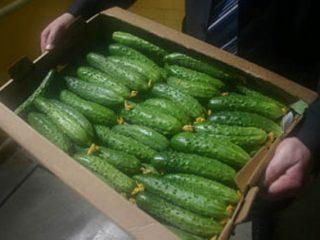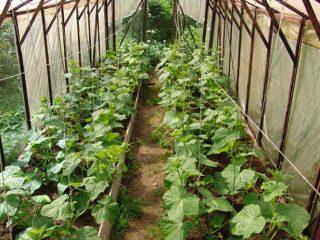Self-pollinating cucumber varieties for open ground and greenhouses, according to ripening time, they are divided into 3 groups:
- Early ripening;
- Mid-season;
- Late.
Tuberous, thick-skinned fruits with dense pulp and black conical fibers on the skin are suitable for pickling and canning.
Early ripening pickling varieties
Cucumber varieties with a growing season before fruiting of 40–45 days belong to the group of early ripening ones.
High-yielding variety “Sibirsky Zasol F1”
The hybrid variety of cucumbers “Sibirsky Zasol F1” that does not require pollination is suitable for pickling and canning. Cucumbers as seedlings or seeds are planted in a greenhouse and open ground under a film covering when the soil temperature reaches 15 degrees. Planting depth is up to 1.5 cm. Productivity increases in warm beds with light soil. Watering is advisable twice a day in the early morning and in the evening after the heat drops.
Active fruiting of “Siberian Salting F1” begins one and a half months after the first leaves appear above the soil surface. The fruit ovaries on the vines are arranged in a cluster.Finely lumpy cucumbers do not outgrow. The optimal size of greens is 6–8 cm. The taste is without bitterness, the average weight of the fruit is 60g. Productivity up to 10 kg per cane. The tetrahedral shape of pickling cucumbers is close to cylindrical.
Ripening is amicable, up to 3 cucumbers are formed in the ovary. An abundance of fruits is obtained in the beds with regular loosening and fertilizing. Spraying the leaves with warm, settled water activates the growing season of cucumbers. They retain their pleasant appearance, fruit density and excellent taste after pickling.
Hybrid fruits are not left for seeds.
Early ripening variety “Murashka F1”
The variety for pickling and canning “Murashka” is an old-timer in the garden beds, known since the 30s of the last century. Due to its popularity, it has undergone more than one selection change.
Zoned for the northern regions of Siberia. Feels great in greenhouses and open beds. Planted with seedlings, the gardener is pleased with the harvest in the first half of June.
The flowering type of the hybrid is female and does not require pollination. The floral axil contains up to 6 cucumber ovaries. The ripening period for greens is 45 days. Productivity reaches 20 kg per square meter. Easily tolerates light shade. It has taken root on balconies and window sills.
The plants are of medium size, throw out 4–6 branches, the leaves are thickened. Needs pinching of excess shoots. Zelentsy large:
- Average weight – 100 g;
- Average length – 11 cm;
- Diameter – 3.5 cm.
The color of cucumbers gradually changes from light green at the tip to dark at the stalk. The thorns are dark and prickly. Suitable for any type of canning. Fruits until frost. Immune to olive spot and powdery mildew. Undemanding to the type of soil. But it will reward you with a harvest for the breathability of the soil. Seed germination rate is 98%.
Cucumber gherkin “Prestige f1”
The early ripening variety of cucumbers for canning and pickling “Prestige f1” is zoned for the West Siberian and Central Black Earth regions.
The bushes are powerful, up to 2 m long, without excess vines. Female flowering type. The growing season before harvesting the greens is 42–45 days. The ovaries are formed in a bouquet of up to 4 pieces in a knot.
- Fruit size – 8–10 cm;
- Fruit weight – 70–90 g;
- Productivity – 25 kg/sq.m. m.
Prestige f1 cucumbers are recommended for commercial production. Friendly ripening of greens and long-term abundant fruiting are characteristic of the hybrid. The fruits do not outgrow and can be stored for a long time after picking before being preserved. They do not suffer from shading or temperature changes. After salting, no voids appear in the fruit pulp. The cucumber variety “Prestige f1” is immune to diseases.
Mid-season pickling varieties
The growing season for self-pollinating varieties for pickling and canning is 45–50 days. The quality of the final product differs for the better in comparison with early ripening ones.
Yield variety "Ginga F1"
"Ginga F1" is adapted to the climate of the Central Black Earth region. The German variety of medium ripening has acclimatized and become popular. This variety of cucumbers for canning is recommended not only for home gardening, but also for commercial production by large agricultural producers. The first greens ripen 46–50 days after germination.
Productivity ranges from 24–52 kg per square meter. Scourges up to 2 m long, no pinching required.
Cucumbers of the “Ginga F1” variety are cylindrical, slightly ribbed, dark green, tuberous with white spines. Often located on the lash. The length is three times the diameter. There are no voids in the seed chamber of the fruit.
- Average fruit weight – 85 g;
- Average fruit length – 10.5 cm;
- Diameter – 3 cm.
The variety is resistant to brown spot, powdery mildew, and cucumber mosaic. Drip irrigation doubles yields. The main purpose of the variety is pickling and canning.
Self-pollinating cucumbers “White Sugar F1”
A new hybrid variety of mid-ripening cucumbers from Ural breeders. The fruits on the plantation stand out with an unusual creamy white color against a green background. Harvesting begins on days 46–50. Rarely tuberous greens have a mild taste. The use of cucumbers is not limited to pickling and canning. They will decorate the salad not only with a rare color, but also with a delicious taste.
The lashes are not spreading; pinching and pinching are not required. The planting pattern is compacted 60x15 cm. Seedlings are planted in open ground no earlier than mid-May.
The variety is characterized by high responsiveness to fertilizing and loosening. It is advisable to collect fruits daily: overgrowing greens inhibit the growth of ripening cucumbers. Marketable fruit size is 8–12 cm. Late-ripening self-pollinating pickling varieties
Late varieties of cucumbers are better suited for pickling and canning. The marketability and taste of the fruits are preserved in the second year of storage.
"Courage F1"
Growing a large-fruited variety for pickling is successfully carried out in the autumn-winter period with artificial lighting and soil heating. Bouquet ovaries of 4–8 flowers allow for massive growth of cucumbers. In combination with simple agricultural technology, this variety is a godsend for farmers and gardeners.
The central stem is not limited in growth, reaching 3.5 m in length. The flowering type is female and does not require pollination. Side shoots produce 20% more fruit.
- Average fruit weight – 130 g;
- Average length – 15 cm;
- The shape of the fruit is a faceted cylinder;
- Diameter – 4 cm;
- Productivity – 20 kg/sq.m. m.
The surface of the thin-skinned dark green fruit is tuberous, with light spines. The juicy light green pulp of the greens is sweetish in taste, juicy, and fleshy. The fruiting rate is extraordinary: the first harvest of cucumbers is carried out 25–30 days after planting the seedlings. Excellent transportability and keeping quality of fruits are additional advantages. After salting, greens do not lose color.
The plant is demanding on the quality of lighting - in shading, the growth of green plants decreases. Untimely or insufficient watering affects the taste of the fruit - bitterness appears. Does not grow well in acidic soils; liming is required at least once every 3 years. The length of the main stem requires the installation of additional trellises.
Planting density is 2–3 plants per square meter.
A gardener's review of cucumbers of the "Courage F1" variety
Gardener's review of the variety "Ginga F1"
















